wheel KIA OPTIMA HYBRID 2019 Owners Manual
[x] Cancel search | Manufacturer: KIA, Model Year: 2019, Model line: OPTIMA HYBRID, Model: KIA OPTIMA HYBRID 2019Pages: 553, PDF Size: 11.97 MB
Page 34 of 553
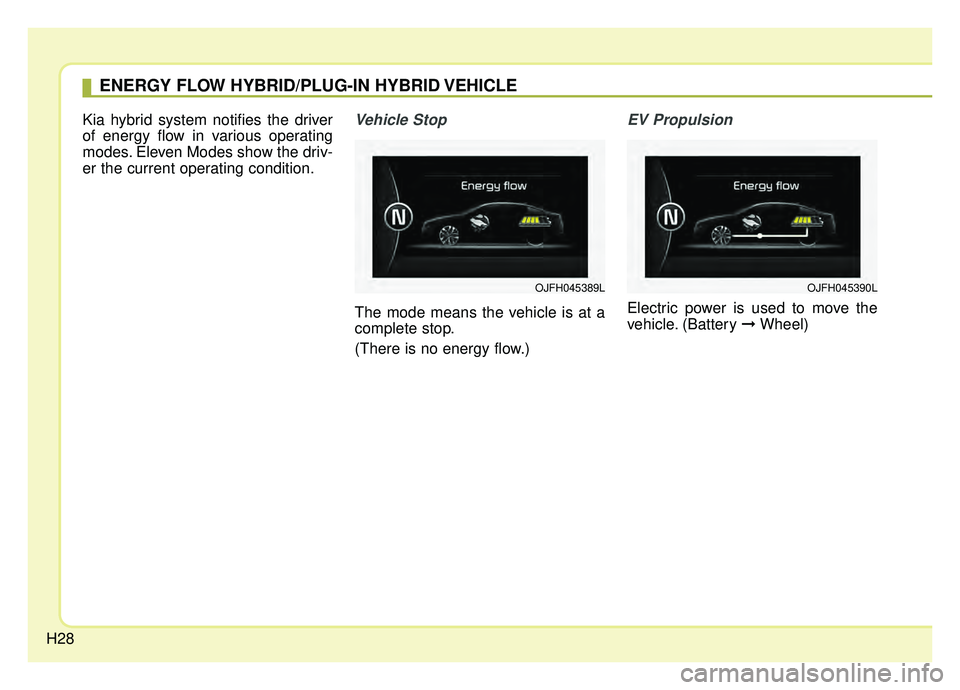
H28
Kia hybrid system notifies the driver
of energy flow in various operating
modes. Eleven Modes show the driv-
er the current operating condition.Vehicle Stop
The mode means the vehicle is at a
complete stop.
(There is no energy flow.)
EV Propulsion
Electric power is used to move the
vehicle. (Battery ➞Wheel)
ENERGY FLOW HYBRID/PLUG-IN HYBRID VEHICLE
OJFH045389LOJFH045390L
Page 35 of 553

H29
Power Assist
Electric and Engine power are used
to move the vehicle.
(Battery & Engine ➞Wheel)
Engine Only Propulsion
Engine power is used to move the
vehicle. (Engine ➞Wheel)
Engine Generation
Vehicle is stopped with the Engine
charging the hybrid battery.
(Engine ➞Battery)
OJFH045392LOJFH045391LOJFH045393L
Page 36 of 553
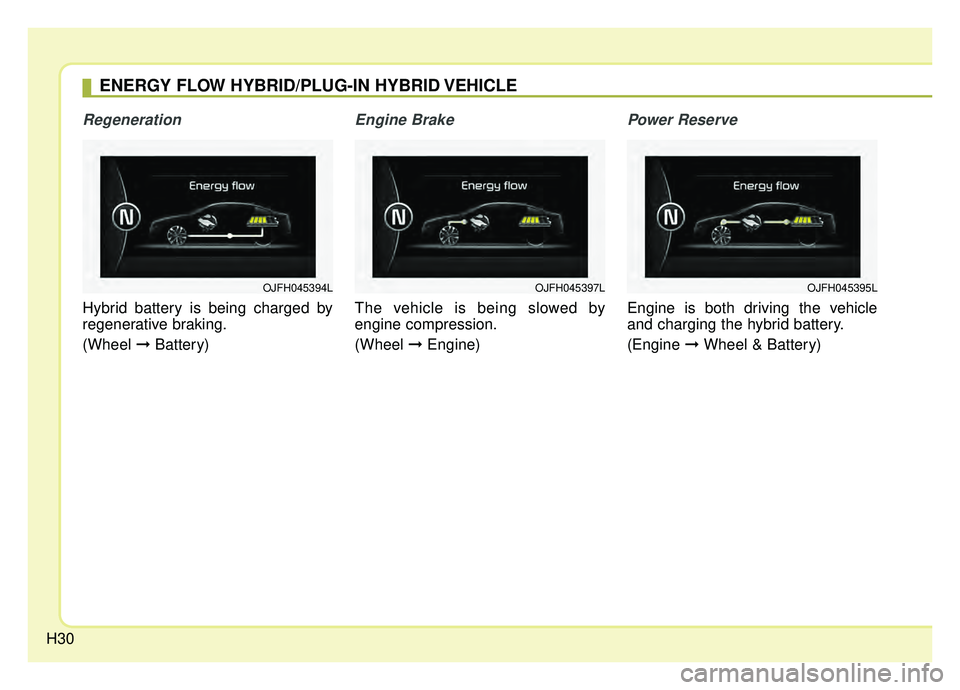
H30
Regeneration
Hybrid battery is being charged by
regenerative braking.
(Wheel ➞Battery)
Engine Brake
The vehicle is being slowed by
engine compression.
(Wheel ➞Engine)
Power Reserve
Engine is both driving the vehicle
and charging the hybrid battery.
(Engine ➞ Wheel & Battery)
OJFH045397LOJFH045395LOJFH045394L
ENERGY FLOW HYBRID/PLUG-IN HYBRID VEHICLE
Page 37 of 553
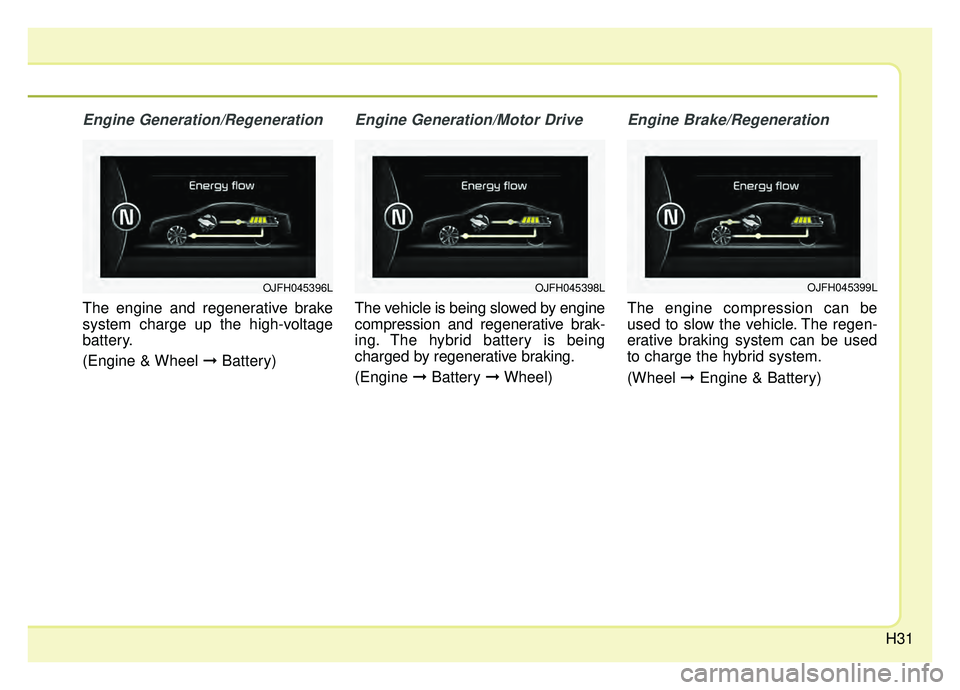
H31
Engine Generation/Regeneration
The engine and regenerative brake
system charge up the high-voltage
battery.
(Engine & Wheel ➞Battery)
Engine Generation/Motor Drive
The vehicle is being slowed by engine
compression and regenerative brak-
ing. The hybrid battery is being
charged by regenerative braking.
(Engine ➞Battery ➞Wheel)
Engine Brake/Regeneration
The engine compression can be
used to slow the vehicle. The regen-
erative braking system can be used
to charge the hybrid system.
(Wheel ➞Engine & Battery)
OJFH045398LOJFH045399LOJFH045396L
Page 56 of 553
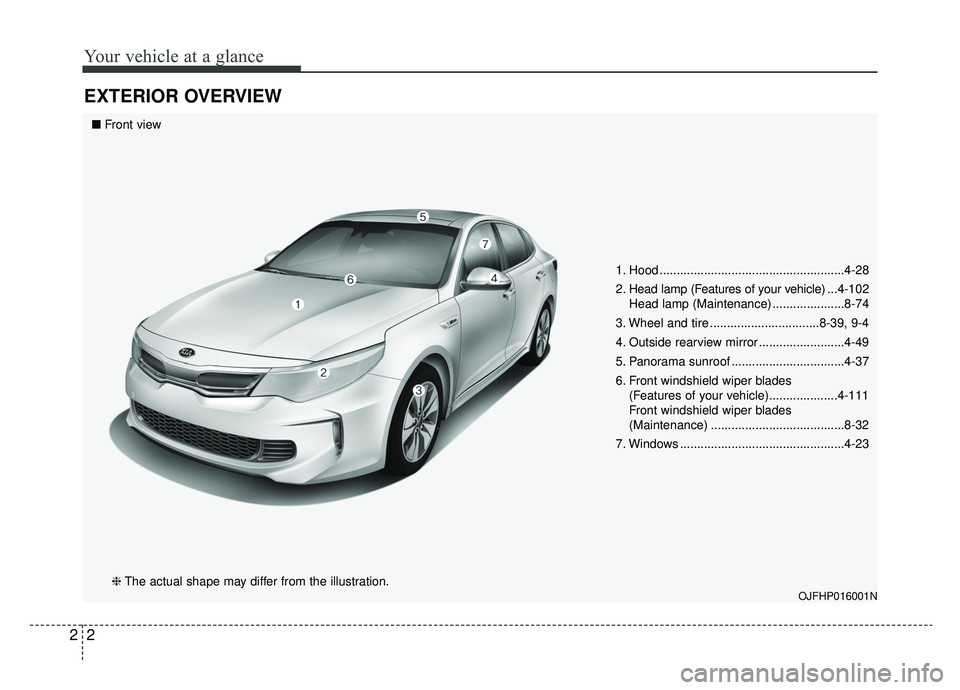
Your vehicle at a glance
22
EXTERIOR OVERVIEW
1. Hood ......................................................4-28
2. Head lamp (Features of your vehicle) ...4-102
Head lamp (Maintenance) .....................8-74
3. Wheel and tire ................................8-39, 9-4
4. Outside rearview mirror .........................4-49
5. Panorama sunroof .................................4-37
6. Front windshield wiper blades (Features of your vehicle)....................4-111
Front windshield wiper blades
(Maintenance) .......................................8-32
7. Windows ................................................4-23
OJFHP016001N
■ Front view
❈ The actual shape may differ from the illustration.
Page 58 of 553

Your vehicle at a glance
42
INTERIOR OVERVIEW
1. Inside door handle ...................................4-14
2. Driver position memory button ................3-11
3. Power window switch...............................4-23
4. Central door lock switch ..........................4-15
5. Power window lock button .......................4-27
6. Outside rearview mirror control ...............4-49
7. Outside rearview mirror folding ...............4-51
8. Fuel filler lid open button ................4-30, 4-34
9. Seat ............................................................3-4
10. ESC off button .......................................6-34
11. Instrument panel illumination control ....4-53
12. BCW On/Off button ...............................6-86
13. LDW On/Off button ................................6-97
14. Steering wheel .......................................4-43
15. Tilt and telescopic steering control lever ....4-44
16. Inner fuse panel .....................................8-66
17. Brake pedal............................................6-19
18. Parking brake pedal...............................6-21
19. Hood release lever ................................4-28
OJFHP018003N❈ The actual shape may differ from the illustration.
Page 59 of 553
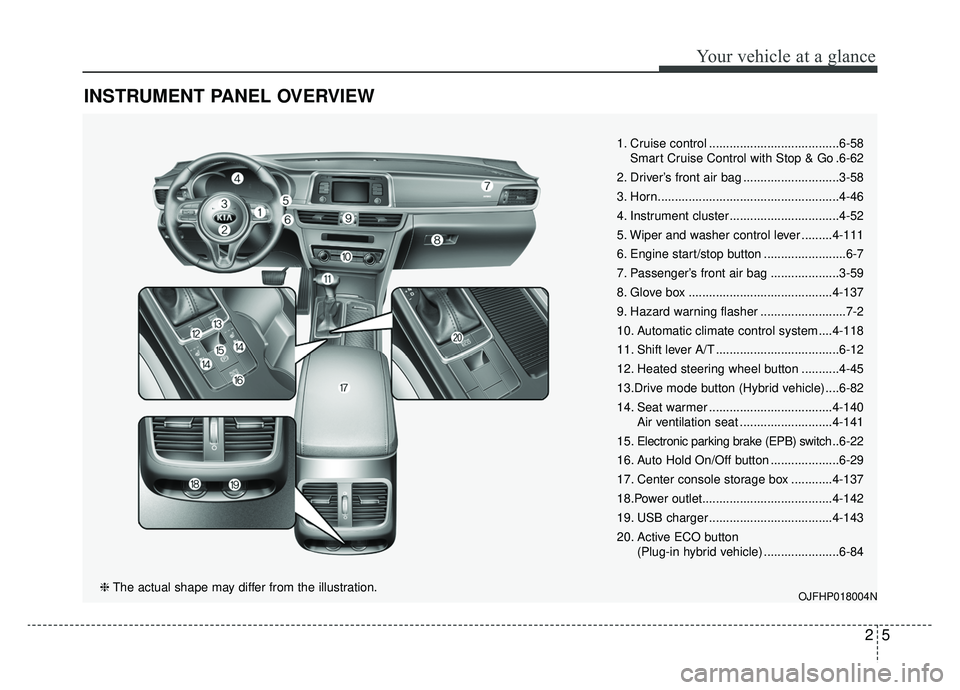
25
Your vehicle at a glance
INSTRUMENT PANEL OVERVIEW
1. Cruise control ......................................6-58Smart Cruise Control with Stop & Go .6-62
2. Driver’s front air bag ............................3-58
3. Horn.....................................................4-46
4. Instrument cluster ................................4-52
5. Wiper and washer control lever .........4-111
6. Engine start/stop button ........................6-7
7. Passenger’s front air bag ....................3-59
8. Glove box ..........................................4-137
9. Hazard warning flasher .........................7-2
10. Automatic climate control system ....4-118
11. Shift lever A/T ....................................6-12
12. Heated steering wheel button ...........4-45
13.Drive mode button (Hybrid vehicle) ....6-82
14. Seat warmer ....................................4-140 Air ventilation seat ...........................4-141
15. Electronic parking brake (EPB) switch .. 6-22
16. Auto Hold On/Off button ....................6-29
17. Center console storage box ............4-137
18.Power outlet......................................4-142
19. USB charger ....................................4-143
20. Active ECO button (Plug-in hybrid vehicle) ......................6-84
OJFHP018004N❈The actual shape may differ from the illustration.
Page 62 of 553

Safety features of your vehicle
23
You will find many safety precautions
and recommendations throughout
this section, and throughout this man-
ual. The safety precautions in this sec-
tion are among the most important.
Always wear your seat belt
A seat belt is your best protection in
all types of accidents. Air bags are
designed to supplement seat belts,
not replace them. So even though
your vehicle is equipped with air
bags, ALWAYS make sure you and
your passengers wear your seat
belts, and wear them properly.
Restrain all children
All children under age 13 should ride
in your vehicle properly restrained in
a rear seat, not the front seat. Infants
and small children should be
restrained in an appropriate child
restraint. Larger children should use
a booster seat with the lap/shoulder
belt until they can use the seat belt
properly without a booster seat.
Air bag hazards
While air bags can save lives, they
can also cause serious or fatal
injuries to occupants who sit too
close to them, or who are not prop-
erly restrained. Infants, young chil-
dren, and shorter adults are at the
greatest risk of being injured by an
inflating air bag. Follow all instruc-
tions and warnings in this manual.
Driver distraction
Driver distraction presents a serious
and potentially deadly danger, espe-
cially for inexperienced drivers.
Safety should be the first concern
when behind the wheel and drivers
need to be aware of the wide array of
potential distractions, such as drowsi-
ness, reaching for objects, eating,
personal grooming, other passen-
gers, and using cellular phones.
Drivers can become distracted when
they take their eyes and attention off
the road or their hands off the wheel
to focus on activities other than driv-
ing. To reduce your risk of distraction
or getting into an accident:
• ALWAYS set up your mobiledevices (i.e., MP3 players, phones,
navigation units, etc.) when your
vehicle is parked or safely stopped.
IMPORTANT SAFETY PRECAUTIONS
Page 63 of 553
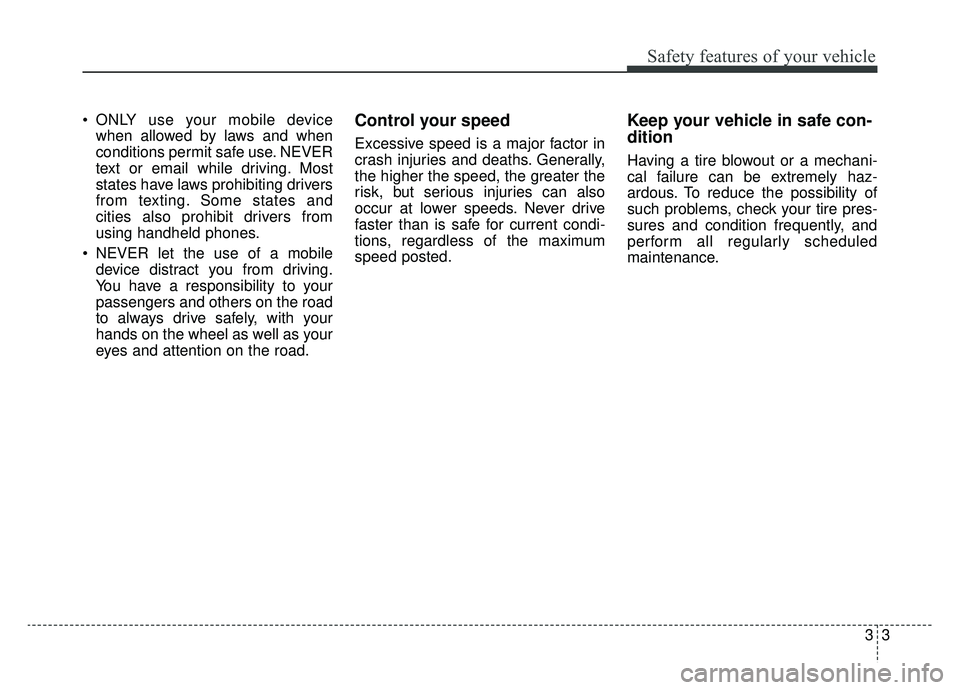
33
Safety features of your vehicle
ONLY use your mobile devicewhen allowed by laws and when
conditions permit safe use. NEVER
text or email while driving. Most
states have laws prohibiting drivers
from texting. Some states and
cities also prohibit drivers from
using handheld phones.
NEVER let the use of a mobile device distract you from driving.
You have a responsibility to your
passengers and others on the road
to always drive safely, with your
hands on the wheel as well as your
eyes and attention on the road.Control your speed
Excessive speed is a major factor in
crash injuries and deaths. Generally,
the higher the speed, the greater the
risk, but serious injuries can also
occur at lower speeds. Never drive
faster than is safe for current condi-
tions, regardless of the maximum
speed posted.
Keep your vehicle in safe con-
dition
Having a tire blowout or a mechani-
cal failure can be extremely haz-
ardous. To reduce the possibility of
such problems, check your tire pres-
sures and condition frequently, and
perform all regularly scheduled
maintenance.
Page 65 of 553
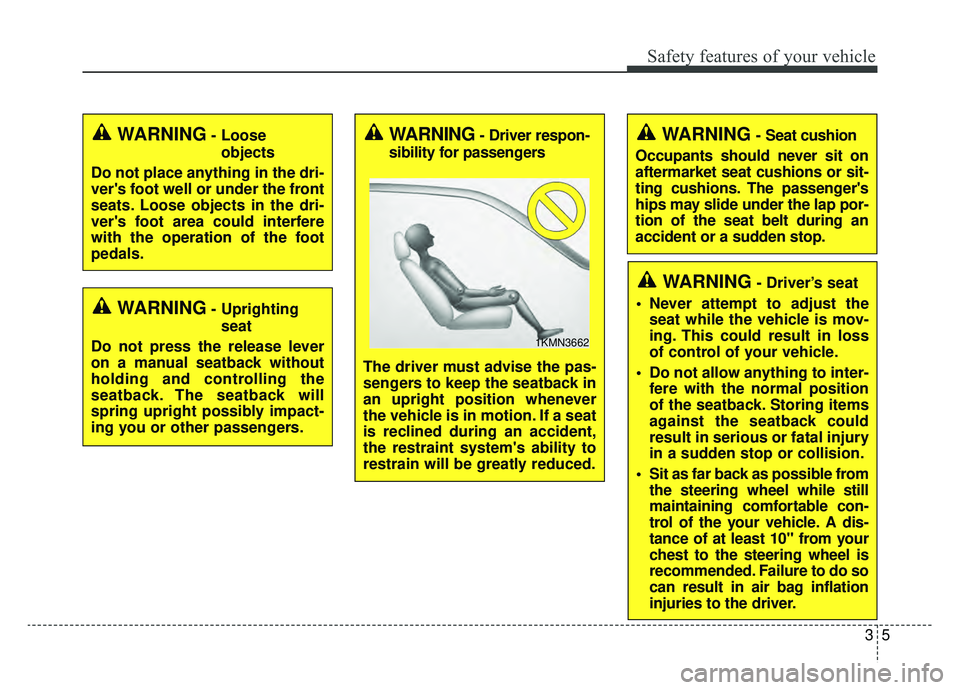
35
Safety features of your vehicle
WARNING- Uprightingseat
Do not press the release lever
on a manual seatback without
holding and controlling the
seatback. The seatback will
spring upright possibly impact-
ing you or other passengers.
WARNING- Loose objects
Do not place anything in the dri-
ver's foot well or under the front
seats. Loose objects in the dri-
ver's foot area could interfere
with the operation of the foot
pedals.WARNING- Driver respon-
sibility for passengers
The driver must advise the pas-
sengers to keep the seatback in
an upright position whenever
the vehicle is in motion. If a seat
is reclined during an accident,
the restraint system's ability to
restrain will be greatly reduced.
1KMN3662
WARNING- Seat cushion
Occupants should never sit on
aftermarket seat cushions or sit-
ting cushions. The passenger's
hips may slide under the lap por-
tion of the seat belt during an
accident or a sudden stop.
WARNING- Driver’s seat
Never attempt to adjust the seat while the vehicle is mov-
ing. This could result in loss
of control of your vehicle.
Do not allow anything to inter- fere with the normal position
of the seatback. Storing items
against the seatback could
result in serious or fatal injury
in a sudden stop or collision.
Sit as far back as possible from the steering wheel while still
maintaining comfortable con-
trol of the your vehicle. A dis-
tance of at least 10" from your
chest to the steering wheel is
recommended. Failure to do so
can result in air bag inflation
injuries to the driver.